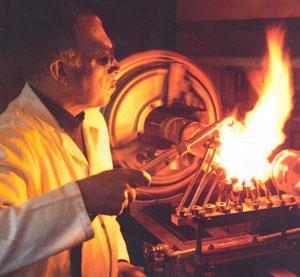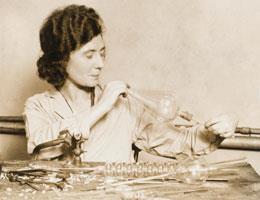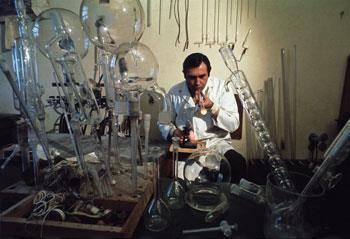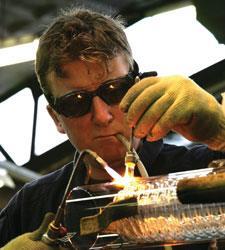Chemistry may have become an increasingly high tech discipline, but it still relies on glassware - and the age-old skill of glassblowing - says Simon Hadlington
Chemistry may have become an increasingly high tech discipline, but it still relies on glassware - and the age-old skill of glassblowing - says Simon Hadlington
If there is one material above all others that defines a chemistry laboratory, surely it is glass. Many aspiring young scientists have been drawn to chemistry by its astonishing range of glassware, in all its fabulous shapes - cones, spheres, coils, flasks squat and wide, flasks tall and thin. All impossibly fragile, yet robust enough to be heated directly on a flame and to carry boiling liquids. And, crucially, transparent, so that the chemist can observe what is happening as the reaction proceeds.
For centuries glass has been central to science. In their book The glass bathyscaphe: How glass changed the world, Alan McFarlane and Gerry Martin describe how they randomly selected twenty famous experiments, and found that fifteen of them would have been impossible without the use of glass tools. These included Lavoisier’s 1777 experiment to heat mercury in air, which would yield key evidence to support his oxygen theory, and Humphry Davy’s discovery of potassium in 1807.

For glass to have these multiple functions it needs to be shaped and worked into the myriad forms that the chemist needs. And it is here that an arcane but vital skill is needed: glassblowing.
In the early years of what we would recognise as modern science, glassware was often prepared by the scientist himself (in those days it invariably was a ’he’). This state of affairs persisted until relatively recently, as William McCormack, honorary secretary of the British Society of Scientific Glassblowers (BSSG) and chief scientific glassblower at the University of Glasgow in the UK, notes. ’For hundreds of years there has been a need for some kind of glass apparatus and instrumentation. But glassblowing as a profession really took off after the second world war. Before then, glassblowing was often done by the scientist, but following [then-prime minister] Harold Wilson’s white heat of technology programme in the 1960s, accompanied by a large expansion in higher education, glassblowing came into its own.’
The burgeoning of science departments in universities around the UK required extensive technical back-up, and glassblowers abounded.

Steve Moehr was one of the glassblowers servicing academic scientists. He worked as a scientific glassblower in universities for 40 years until his retirement two years ago as chief glassblower at the University of York, UK. ’I left school at 14 and because I was good with my hands I joined the glassblowing workshop at the University of Leeds for a five-year apprenticeship,’ Moehr recalls. ’It was an interesting job. The glassware we would make could be highly complicated - tubes within tubes within tubes. You would get a drawing from an academic and you would say "I can’t possibly do that"; then of course I would do it. They would come back and say it doesn’t work, and it needs a tube in here and one out of there. Or they would drop it...’
Hopping the cracks
For Moehr one of the most complicated pieces of apparatus he was regularly required to make was a so-called three-stage mercury diffusion pump, a device for creating high vacuum and one that has largely now been superseded by mechanical vacuum pumps. These were highly elaborate pieces of equipment.
’It was terrific fun making equipment like this,’ Moehr says. ’You would spend maybe a couple of days preparing all the bits, adding different parts then finally fitting them all together. This is where the trouble could come - it could crack at this stage and it often did.’
Ingenuity and resourcefulness was also required. Moehr describes one memorable job. ’I was commissioned by one professor to make a fused silica microbalance, which required a hydrogen and oxygen flame to melt the silica, and needed fibres of diameter in the region of only two or three microns. I had to do it under a microscope with a flame that I could hardly see. To make the fibres I took pieces of fused silica rod of one millimetre diameter and I hung a bulldog clip off the end. I held the rod up and melted it in the middle; it would drop, drawing the fibre out to the kind of tiny diameter I needed.’
Over the course of the four decades that Moehr spent in the trade, he did see changes. ’I suppose one of the main things is that glassblowing has declined. Partly this is because glass does break easily and there had been a move to replace some of the equipment with metal and other materials. Also, 40 years ago there was a lot more innovation in equipment. Chemistry was a much younger science and one remembers laboratories full of chemicals in various wonderful vessels bubbling away - more so than these days perhaps.’
Moehr’s successor at York is Brian Smith, who has also been glassblowing for 40 years. ’Glassblowing itself has probably changed little over the past 150 years,’ says Smith. ’What does change is the type of equipment we make as new technology develops. We do make a lot of vacuum lines to order. A researcher will give me a drawing and we can work from that.’
Of course the flip side to the magic of glass, the transparent material that can be formed and manipulated into almost any shape, is that it is fiendishly fragile. ’It can be extremely frustrating,’ Smith says. ’A job will never go wrong at the beginning, only at the end as it gets more complicated. If you have spent two or three days building a component up, the last joint you put on will be the joint that cracks and writes the job off.’
Breakages are inevitable, Smith concedes, but not always. ’Please, if joints won’t come apart, don’t try to force them - they will break. Bring them to the workshop!’ But despite these frustrations, the job remains, Smith says, highly fulfilling. ’It is an unusual profession, and frankly not anyone can do it. And in this job you literally never know what is going to come through the door next.’
Big projects
As well as academic research, glass is also key to the chemical and pharmaceutical industries, albeit on a larger scale.
Graham Reed is a past chairman of the BSSG who until recently had his own scientific glassblowing company servicing the commercial sector. ’Glass has been absolutely vital to science in the past, as it is now and will be in the future,’ he says. Reed confesses to having had an obsession with glass since seeing a craftsman fashioning novelty animals from glass in a department store when he was a child. He was offered a glassblowing apprenticeship with the then Mullard factory in Southampton in the 1960s making radio valves.
’I eventually ended up at the University of Stirling in Scotland in the early 1980s where I took over the glass workshop. After a while I discovered a goldmine in central Scotland - there were no commercial glassblowing resources at all to service a rapidly growing chemical and biotechnological industry. ICI, Beechams, Glaxo and many start-up companies were based there, desperately trying to catch up with Japan and the US.’

The services of the university glass workshop were contracted out to these companies. ’Within no time I was making pots of money for the university, generally with repair work,’ Reed recalls. ’Unlike many university-based glassblowers, I was happy dealing with flasks two or three feet in diameter. At the time no-one was repairing this stuff; if it got a chip in it, it became useless because it would be impossible to get a seal. So I brought in a lot of business for the university. But by the mid- to late-80s the university decided it needed my workshop space more than it needed the business I was generating - so it encouraged me to go private.’
Engineering in glass
It takes around five years to become a competent glassblower. Bob Hilliard of specialist glassblowing company Labglass says that while his trainees are expected to start making a contribution to their salary costs within 12 months, ’we are looking at ten years before they would be fully competent to tackle everything which comes through the door.’

Unlike conventional glass blowing, where a mass of molten glass is inflated into a bubble through a blowpipe, a scientific glass blower is more of a ’glass engineer’. For scientific glassblowing in a research laboratory, the main raw material is glass tubing, in diameters ranging from 2-3mm to 150mm. There are three types of glass: soda glass, which is typically used for items such as measuring cylinders that will not be heated appreciably; borosilicate glass, which is heat resistant (Pyrex is one of the best known manufacturers of borosilicate glass products), and quartz, which is for very high temperature, high purity work. Joints, taps and seals are bought in. The glassblower cuts the tubing to the required length and heats it in a flame of appropriate temperature to melt the glass to allow it to be formed and fused with other components. This requires considerable manual dexterity. Larger components can be mounted on a lathe. Once the piece of apparatus has been made it needs to be heated in an oven to remove internal strain, a process termed annealing.
So Reed set up his own company. ’The repair side of the business was great during the recession of the 1990s. If you want a good economic indicator of a recession, one of the best ways is to take a look at a company’s R&D budget - always the first thing to get the chop, so repair work tends to go up. Rather than spend ?200 to get a new flask, they need only spend ?50 to get it repaired.’
Reed also carved himself a niche in customised glassware for these companies. ’This was the real skill,’ he says. ’I could do it because I lacked fear of big jobs - I have made some really big items for these firms.’
Reed cites jacketed vessels as requiring particular skill. ’These are pressure vessels for high vacuum work. A highly exothermic reaction needs to be cooled, maybe down to minus 40 or 50?C. To do this you need at least a double layer of glass - when you are dealing with very low temperatures ice can form around the vessel, but it is important to be able to see inside it, so a third layer is made which can be evacuated. Not only do you need to fashion the layers of the vessel, but you need tubes going through them, connected by valves and taps, often the vessels contain baffles; everything needs to be sealed correctly. It can get highly complicated.’
Two of the youngsters that Reed trained were Craig Martin and Brian Godsman. Five years ago they set up their own company in Scotland, ScottGlass, which works with many biotechnology and pharmaceutical companies that specialise in low-volume, high-value products. ’One of the interesting trends in this business is that while a lot of the glass work has gone to China, the Chinese are only interested in doing things in massive numbers,’ Martin says. ’That has left an opportunity for smaller, local specialist sources such as ourselves.

’Most of what we do is big and actually quite intimidating. We get asked to do 20- or 30-litre reaction vessels with a highly specific set of parameters which are unusual. In the past you had sprawling labs with lots of twisty bits of glass with stuff bubbling away, but now it is a bit more sophisticated. People are saying, "we want to make this type of drug: what can we make it in?" We work closely with the client to come up with the final design.’
As for the future of scientific glassblowing, opinions vary. Many glassblowers are fearful for the future of the craft. ’There has been a collapse in technician numbers over recent years,’ McCormack says. ’When I started 30 years ago there were three workshops and six glassblowers. Now I am on my own.’
Steve Moehr says, ’There are not many people coming into the trade nowadays; it is a dying craft.’
Mike Souza, a past president of the American Scientific Glassblowers Society and a glassblower with
35 years’ experience, says that the decline in scientific glassblowing can also be seen in the US. ’Chemistry has quickly evolved through advances in analytical chemistry, the impact of MRI, chromatography, computer modelling software and combinatorial techniques,’ he says. ’All of these innovations have had an adverse effect on the manufacturing of glass-blown instruments.’
Souza notes that his employer, Princeton University, had as many as five glassblowers 50 years ago, whereas now he is the only one. ’I don’t think that there is another university in this country that employs more than one person,’ he adds.
Bob Hilliard, director of Labglass, a specialist glassblowing company in the UK that employs six glassblowers, is not so gloomy. ’We are investing at the moment so we see it as being a fairly stable market. It is a matter of supply and demand.’
Despite the drop in numbers of technicians in the academic sector, new recruits continue to enter the profession. Abigail Storey is a trainee glassblower at the University of York. Having graduated in glass and ceramics, Storey was no stranger to working with glass. ’The type of work I do now is much more hands-on than with the work I did on my course,’ she says. ’Here you are much closer to the flame, and every slight movement with your fingers is translated to the glass - it is very precise and you are very much in control of what happens. What is most satisfying to me is that you change the glass from a straight length of tubing which has no real application into something which is functional and which someone will find useful. But it is incredibly difficult to get the basic skills needed. You have to develop a kind of sixth sense, a feel for the glass and how it interacts with the flame.
It might look easy but it isn’t!’
Simon Hadlington is a freelance science writer based in York, UK
Further Reading
Alan MacFarlane and Gerry Martin, The glass bathyscaphe: How glass changed the world. London: Profile Books, 2002






No comments yet